Best gaming monitors in 2024: the pixel-perfect panels I'd buy myself
The best gaming monitors balance price with panel quality, resolution and refresh rate.
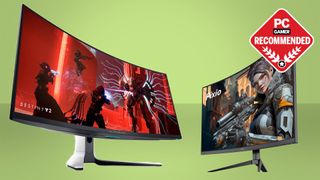
📺 The list in brief
1. Best overall
2. Best 4K
3. Budget 4K
4. Best 1440p
5. Budget 1440p
6. Budget 1080p
7. Best ultrawide
8. Budget ultrawide
9. Best 42-inch
10. Best 32-inch
11. Also tested
12. How we test
13. Find the deals
14. FAQ
15. Jargon buster
The best gaming monitor is an incredibly important piece of a PC gamer's setup. Why spend lots of money on a gaming PC if you're going to play it through a tiny, 20-year-old workstation monitor? Fortunately, there are many great gaming monitors available today, including those offering ultra high-refresh 1080p, zippy 1440p options, high-fidelity 4K, and a slew of ultrawide panels.
While we're expecting further fantastic panels throughout 2024, right now the best gaming monitor is the Alienware 34 QD-OLED. It uses the same excellent Samsung OLED panel as its more expensive Alienware sibling with G-Sync functionality and has the same glossy, mildly reflective coating that the more expensive Philips Evnia 34M2C8600 also comes with. And it's absolutely ace. Check out our guide to the best OLED gaming monitors for even more options.
You need to match your monitor choice with your PC specs to get the most for your money. A 4K monitor with a high refresh rate would be overkill if your rig only packs a GTX 1060, and for those cases, the BenQ Mobiuz EX240 is the best budget 1080p monitor at the moment. If you prefer high refresh over resolution, check out our guide to the best high refresh rate gaming monitors.

Dave's been testing PC hardware for the best part of 20 years and has seen every kind of screen imaginable. As such he knows what makes a good gaming monitor and what makes a bad one, too. Whether it's LCD, OLED, mini-LED, or plain ol' CRT, he's had his eyeballs on them all and has personally checked out all of the best gaming monitors on this list.
The Quick List
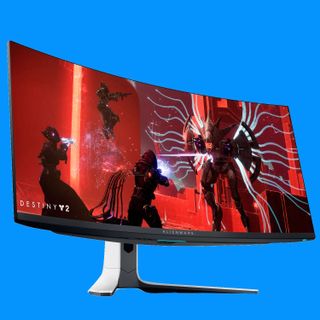
The best overall
Alienware and its use of the Samsung-made QD-OLED panel, has created the best gaming monitor, and changed the perception of OLED screens for gaming. This is the cheaper version of Alienware's OLED and the better, glossy version.
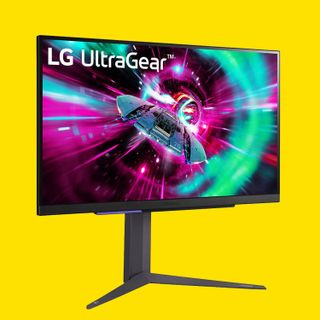
The best 4K
The LG UltraGear 27GR93U is LG's IPS tech at its best. It's absolutely gorgeous with colors that are accurately calibrated. With key gaming quotas reached for refresh rate and response time, it's the best in show for a standard 4K panel.
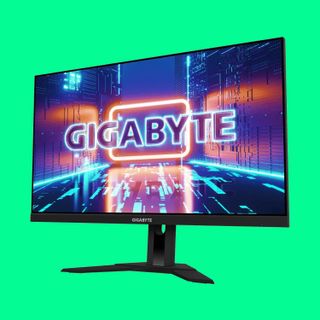
The best budget 4K
Gigabyte's more affordable 4K monitors go down a treat with us. They're fast and bright where it counts, and they offer USB hubs despite their good value. The stands are a bit basic, but we'll take it.
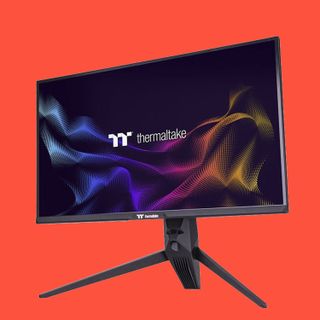
The best 1440p
Thermaltake has stormed out the gate with its first gaming monitor; it's a zinger. A 27-inch IPS panel with a 165Hz refresh rate and 1ms response—standard, yes, but it's really good looking.
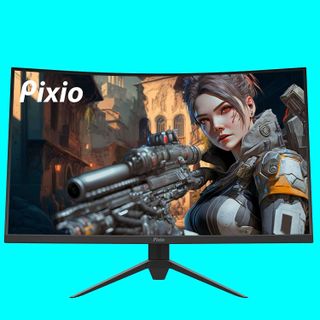
The best budget 1440p
The PXC277 doesn't look like a bargain basement item it might have done. At this price point, we were willing to make a few excuses, but that's not actually necessary. This monitor delivers: The Pixio PXC277 Advanced does almost everything pretty darned well.
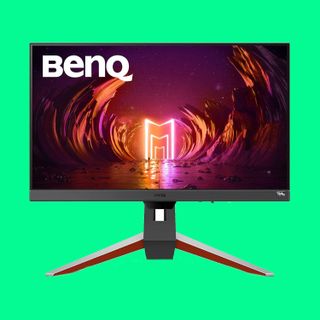
The best budget 1080p
Strictly not to be confused with the Mobiuz EX240N—and that's very important, because it's a far worse monitor—this 1080p IPS display is a proper 165Hz gaming monitor that ticks all the boxes for mainstream PC gaming.
⬇️ Click to load more of the best gaming monitors ⬇️
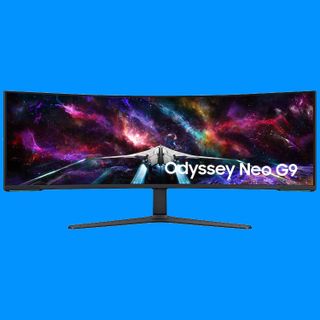
The best ultrawide
This dual-4K monster does things no other gaming display can. Admittedly, the mini-LED technology can't match OLED for lighting precision and panel response. And it costs an enormous pile of money. But this is still the most spectacular gaming experience currently available.
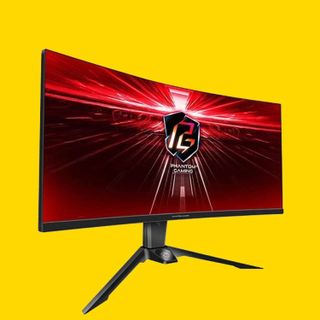
The best budget ultrawide
A contrasty VA panel, plenty of backlight punch provided you run the screen in HDR mode (where SDR content looks better anyway), reasonable pixel response, and high enough refresh for most gamer's purposes. That you can have all this for $370 is fantastic.
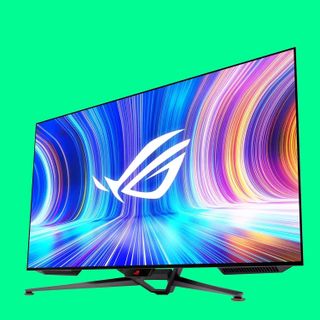
The best 42-inch
The ROG Swift brings all the best parts of the LG C2 into the gaming space, improving it in a host of ways that gamers will be better pleased with. Sure the adjustments are limited, but the PG42UQ is a gamer's bestie where it matters and another champion for the OLED cause.
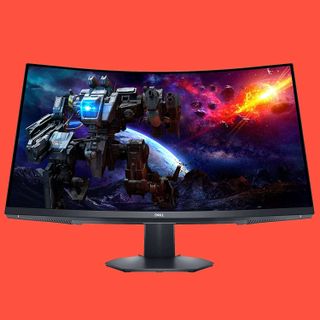
The best 32-inch
It's worth remembering that pricing for this class of display—a 32-inch 165Hz 1440p panel—extends all the way up to $800 in the Corsair Xeneon 32QHD165. So, while the Dell S3222DGM isn't all that exciting from a technical point of view, for the money, it's very convincing.
Recent updates
Updated February 8, 2024 to make it even easier to find the right monitor for your needs and budget, by including clear 'Should I buy it or not?' information in each category.
Best gaming monitor overall







Specifications
Reasons to buy
Reasons to avoid
✅ You want the best gaming monitor on the market: The combination of Samsung's fabulous OLED panel, superb HDR performance, glossy finish, and ultra-fast pixel response is as good as gaming monitors get right now.
❌ You need 4K Ultrawide: This format might be gaming nirvana but ultrawide 4K OLEDs are all massive in size at the moment. Smaller 4K 27- or 32-inch OLED screens are likely to arrive within a year.
The best gaming monitor today is the fantastic Alienware 34 AW3423DWF QD-OLED. You might have already seen or owned an OLED TV for a while, but this panel technology has finally made it to the world of gaming monitors. Alienware has been leading the charge with some fantastic OLED models, often beating out Philips and OLED panel maker LG with its impressive screens.
What we love about the Alienware 34 AW3423DWF is its glossy panel. I know that might sound trivial in the grand scheme of things, but this anti-glare coating, in place of the OG model's matte coating, makes all the difference.
When Alienware wheeled out what was the world's first OLED gaming monitor, the Alienware 34 AW3423DW, it went straight to the top of the table. It was simply stunning. But it wasn't, you know, actually perfect but now we have another 34-inch ultrawide Alienware OLED monitor. It looks nearly identical but costs several hundred dollars less. So what, exactly, is going on?
The new Alienware 34 AW3423DWF adds an "F" on the end and loses a few on-paper features in the quest for that lower price point. For starters, the mostly pointless Nvidia G-Sync Ultimate certification and the costly G-Sync chip it requires have been ditched.
In its place you get AMD's Freesync Premium Pro and therefore perfectly adequate adaptive refresh support. Speaking of refresh rates, this new F model steps down from 175Hz to 165Hz. You're never going to feel that difference in-game and it seems like the sort of minor spec tweak designed for product differentiation. You know, to help Alienware justify the price of the more expensive model: it's 10Hz faster!
Whatever, those details aside you're mostly getting the same 34-inch ultrawide and slightly curved proposition as before. The Samsung QD-OLED panel is carried over, which is a very good thing.
This Alienware does have a brightness limiter, but it's far less aggressive than on most LG-equipped monitors and you barely notice it happening. More to the point, this monitor always looks punchy, which you absolutely cannot say of monitors with LG OLED tech.
In fact, it's better than that because the glossy really lets the OLED panel sing. In that regard, it's just like the Philips Evnia 34M2C8600, which is another member of the Samsung QD-OLED gang and also has a glossy anti-glare coating. It does wonders for black levels and contrast. Along with the Philips, this is simply the best HDR gaming experience you can currently get.
Incidentally, the coating is very well judged. It's not over reflective and distracting in that regard. It just ups the contrast and removes that slight greying of darker tones that comes with a matte coating.
This Alienware is cheaper than the Philips Evnia and compared to that monitor is only missing a USB Type-C connection, which in a gaming context isn't a huge loss. Current USB Type-C power delivery is limited to 100W, which isn't enough to keep a gaming laptop juiced, anyway.
As for reservations, well, once again it's the same story as the OG Alienware OLED. For general computing, the pixel density ain't great. It doesn't make for truly crisp fonts in Windows or super sharp image detail. The triangular rather than vertically striped RGB subpixel substructure doesn't help with text clarity, either.
And of course, this is still a very expensive monitor, even with any discounts. But you can still ink the new Alienware 34 AW3423DWF in as our new favourite gaming panel. Because it's absolutely farking fabulous.
Read our full Alienware 34 AW3423DWF review.
Best 4K gaming monitor






Specifications
Reasons to buy
Reasons to avoid
✅ You want a top-notch 144Hz 27-inch 4K gaming panel: While this LG model doesn't offer anything especially new, what it does have is all exceptionally good.
❌ You want the best value for money: At this price point, there are lots of choices on the market. It's very expensive for a 27-inch gaming monitor with limited HDR support.
The LG UltraGear 27GR93U is the best 4K gaming monitor for its stellar picture quality and all-round performance. It might not be the flashiest monitor around, but it delivers the fundamentals of a great 4K gaming monitor better than most.
LG makes a lot of panels for monitors, but it's paid particular care with this monitor to tune it wonderfully out of the box. Just plug this monitor in, boot up your favourite game (I recommend something vibrant, like Avatar: Frontiers of Pandora) and you'll quickly realise just how gorgeous this screen is. There's loads of pop to the picture without going overboard and oversaturating.
As a 27-inch, 4K panel, the resolution squeezes plenty of pixels per inch. That means it's a supremely clear picture and great for gaming but also showing off lots of text. That said, it's not as immersive as some ultrawide gaming monitors, which will wrap around your vision, and being a full 4K panel this LG will actually often require more computational power than most traditional ultrawides with fewer pixels overall.
That's the thing, you will need a mighty graphics card to run this UltraGear gaming monitor at its fullest. It runs up to 144Hz, which is attainable with modern GPUs, though you'll likely want to turn to upscaling methods to help you reach full speed. It depends on the game, however.
We recommend you switch on HDR with this monitor, despite it only scraping in with 400 nits of peak brightness. It still looks really great with both HDR and SDR content with HDR enabled, which is a pleasant surprise.
The LG UltraGear 27GR93U is a really strong pick for single-player gamers looking for a gaming monitor that will show them the best of their games and the best of 4K gaming. Also, it's great for editing content on and working with throughout the day—it's a really flexible monitor. Though not literally, unlike some, so don't try and bend it in half.
While you do have to pay for the privilege of this LG UltraGear gaming monitor, it's quite simply the best all-round 4K gaming monitor we've tested.
Read our full LG UltraGear 27GR93U review.
Best budget 4K gaming monitor




Specifications
Reasons to buy
Reasons to avoid
✅ You want a great budget 4K panel: High resolution panels are a joy to work and play on but they're usually very expensive. Not this one.
❌ You don't have a powerful graphics card: As with all 4K panels, running it at a lower resolution doesn't look nice and you really need a top-end GPU to make the most of this monitor.
The best budget 4K gaming monitor is the Gigabyte M28U. And yeah, budget and 4K are not words often seen together. Yet Gigabyte is offering a cheaper 4K panel than most here, and yet it's still a glorious IPS.
With a 28-inch IPS panel, the M28U offers plenty of pixels per inch. The result is a super clear and crisp picture while gaming, which is paired well with the rich tone of the IPS. For a bright and vibrant game such as Deathloop, it's honestly stunning. As long as you avoid using it in HDR mode, that is, as like many IPS panels it doesn't offer the best HDR experience out there.
What's impressive about the Gigabyte M28U is just how much is stuffed into the Gigabyte M28U for the money. Beyond the pretty speedy IPS panel, there's a USB hub on the rear that includes multiple Type-A connections. Useful if you want to keep your cables tidy and run your mouse and cable directly to the monitor itself.
The stand is perhaps the only let-down on the M28U, but I'm willing to let this one slide. It's sturdy enough and offers some height and tilt adjustment, but it's a bit plasticky and not altogether as flexible as some. Though something had to give for this price bracket, and I'm happy it's the stand that's been trimmed back rather than the panel or refresh rate.
You can't go wrong with the Gigabyte M28U, assuming you have the graphics card capable of driving it. We've been using this monitor in the team for over two years now and it's still performing as well as the day we got it.
Read our full Gigabyte M28U review.
Best 1440p gaming monitor





Specifications
Reasons to buy
Reasons to avoid
✅ You want the best 1440p monitor: Thermaltake hasn't rewritten any rules with this model but it has produced a very good 1440p gaming panel.
❌ You want to power a laptop with the USB hub: The KVM switch is very useful but the 15W USB-C power delivery is barely good enough for a phone, let alone another PC.
A surprise hit, the Thermaltake TGM-I27FQ is our pick for the best 1440p gaming monitor. It's a prized and heavily contested spot, too. I think many PC gamers would agree that 1440p and 165Hz is the perfect blend of speed and resolution, and that means there are heaps of gaming monitors vying for your attention. But the TGM-I27FQ has absolutely got ours.
This is one of the first gaming monitors out of Thermaltake. Ever. You wouldn't expect such high results from a new entrant, yet it's becoming something of a theme in gaming monitors. After all, ASRock's first line of gaming monitors are also fantastic, and superb value. But less about them, let's talk Thermaltake.
At 27 inches, this is about as big as you'd want to go at 1440p. While bigger is certainly possible (we recommend an option for that, the Dell S3222DGM below), you'll start to notice each pixel as the pixel density decreases. The Thermaltake offers a decent density by comparison.
With a 165Hz refresh rate, 1ms response time, and IPS panel, Thermaltake is ticking all the boxes we would like to be ticked with a 1440p gaming monitor. In a way, then, this monitor isn't doing anything radical, but it's the best of a well-priced bunch that we've seen in getting this stuff right.
The stand is also solid here, and offers proper adjustments including rotation, if you're into that. The only weird bit of this entire monitor is the little Thermaltake logo projector, which I'd rather Thermaltake kept for themselves. I don't need a brand name beamed onto my desk, thank you very much. At least the RGB lighting on the rear isn't so egregious.
With both AMD and Nvidia variable refresh rate support, this is what we'd consider a great 1440p gaming monitor for a wide range of PC gamers.
Read our full Thermaltake TGM-I27FQ review.
Best budget 1440p gaming monitor





Specifications
Reasons to buy
Reasons to avoid
✅ You want a great value 1440p monitor: You're getting a spec list here that would have set you back double this price just a few years ago.
❌ You want to use HDR in games: The peak brightness and weak backlighting don't help the HDR experience, so you'll be sticking to SDR at all times.
What are the actually essential ingredients for a good gaming monitor and how much will that cost you? On paper, the answer might just be $240 with the new Pixio PXC277 Advanced. It's a 27-inch 1440p panel with 165Hz refresh and 1ms claimed response. Oh, and HDR support. That's one heck of a package for the price and easily the best budget 1440p gaming monitor.
It also meets pretty much all our key metrics. 1440p on a 27-inch panel remains a great all round compromise between size, pixel density, and GPU load. Likewise, 165Hz is plenty for all but the most demanding esports addicts. Ditto 1ms response, in theory.
Ostensibly, there's HDR support but unsurprisingly, the backlight is monolithic. There's no full-array local dimming and the rated brightness tops out at 320 nits, which is modest by today's standards.
As for the actual image quality and gaming experience, well, there are no immediate horrors. Phew. The panel's default calibration is reasonably accurate and there are none of the weird sharpening filters or backlight blotchiness you sometimes see on really cheap panels.
Even with the backlight set to maximum, this admittedly isn't the punchiest display. But it's reasonably vibrant and the inherent contrast of the VA panel tech delivers good black levels. The basic desktop experience in SDR mode is pretty pleasing.
Less impressive, predictably, is the panel's HDR performance. It will process an HDR signal and punch out broadly correct colours. But it's not remotely a real HDR experience. The HDR calibration also has some compression at the high end which results in bright details being blown out.
Thankfully, with slim bezels on three sides, plus a bit of a chin, and a crisp metal stand, the PXC277 doesn't actually look like a bargain basement item it might have done. The external power supply does admittedly drag the tone down. It's a generic item with a cheap looking Pixio sticker slapped on the side. And the aforementioned stand is tilt-only.
But you know what? This monitor delivers. At this price point, we're willing to make a few excuses. But that's not actually necessary, as the Pixio PXC277 Advanced does almost everything pretty well.
Read our full Pixio PXC277 Advanced review.
Best budget 1080p gaming monitor








Specifications
Reasons to buy
Reasons to avoid
✅ You just want a great budget 1080p monitor: There are no frills or fancy tech here, just a good, solid panel that's fast and looks nice.
❌ You're expecting decent HDR support: While it can handle a HDR signal, this BenQ panel is far better suited to SDR gaming. You'll only be disappointed if you try to run it in high dynamic range.
You can find similar screens for less money, but there are few genuinely affordable entry-level screens as good as the BenQ Mobiuz EX240 and it's by far the best budget 1080p gaming monitor.
It's especially a good fit for competitive gamers who don't want to break the bank. In an age of megabucks GPUs, $200/AU$279 seems like a pitiful amount of money for, well, almost anything. But BenQ is here to tell you it's enough for a pretty darn good gaming monitor.
On paper, this 24-inch panel ticks a lot of boxes for entry-level esports. It's a 1080p model—predictable enough—hits 165Hz and offers IPS panel tech with 1ms response times.
BenQ rates the Mobiuz EX240 at 350 nits peak brightness and includes HDR10 support. There's no VESA certification or local dimming, though. So this isn't a remotely serious attempt at an HDR panel, but it will process an HDR signal correctly, which is something.
As for actual image quality, the first out-of-the-box impressions are good. This is a pretty vibrant, punchy panel. The viewing angles are good and the default color calibration betrays no real nasties. There is a little compression at the darker end of the color spectrum. But, generally, this monitor has been fairly well set up well.
Head in-game and the good news continues. BenQ claims a 1ms response by the MPRT metric. In broad terms, MPRT response figures tend to be lower than grey-to-grey for a given monitor, putting this panel roughly in the 2ms region for GtG response.
And it feels very much good for 2ms. This is a snappy little panel. In subjective terms, there's little to separate it from the best 1ms GtG IPS monitors. Sure, you could tease out the differences with high speed photography, but in terms of actual gameplay, motion blur is kept to a thoroughly acceptable minimum.
All told, there's a lot to like here. Granted, this monitor has plenty of limitations. 1080p feels pretty stingy these days as native resolutions go, but on a smallish 24-inch monitor, the pixel density is tolerable and the main benefit is that you don't need to be raiding multiple bank accounts to pay for this monitor.
That you can have a decent IPS gaming panel running at 165Hz with good pixel response, reasonable overall calibration, generally punchy and pleasing image quality, and nice low latency, all stuffed into a good looking chassis, for just $200/AU$279 is a blessed relief. For that, we can only tip our hats to BenQ for doing such a nice job.
Read our full BenQ Mobiuz EX240 review.
Best ultrawide gaming monitor



Specifications
Reasons to buy
Reasons to avoid
✅ You want the ultimate gaming experience: This level of pixel density has never been available before on such a large screen and it's incredible to see.
❌ You're expecting OLED-levels of perfection: Samsung has done a great job of improving its VA panels, but it's still no match, in terms of image quality and speed, as a decent OLED monitor.
The incredible, preposterous new Samsung Odyssey Neo G9 G95NC Dual UHD is the best ultrawide gaming monitor money can buy right now. This is no thinly disguised TV: It's a proper PC-optimised panel. And yet this 57-inch uber-wide monster still has us wondering if you can have too much of a good thing.
What you're looking at, in effect, is a pair of 32-inch 240Hz 4K gaming monitors fused into a single 57-inch ultra-curved panel. So, that's no fewer than 7,680 by 2,160 pixels, or just over 16.5 million in total and twice that of 4K.
When we say the best ultrawide, then, we're really talking about a panel of unprecedented proportions.
A single 240Hz 4K monitor would be pretty special. But double that resolution running at such a high refresh rate is genuinely unprecedented. Indeed, it's so novel that only AMD's latest RDNA 3-powered Radeon RX 7000 Series GPU can hit the full 240Hz courtesy of their DisplayPort 2.1 interfaces. Nvidia's RTX 40-series GPUs are limited to DP 1.4 and can only do 120Hz, at this resolution.
Of course, you could argue that's usually going to be an academic problem. You've got zero chance of hitting 240Hz at dual 4K in Cyberpunk with all the ray-tracing twangers maxed out, or any other graphically demanding game, even on an RTX 4090. It is a bit problematic that this most demanding of PC monitors can't run at full performance with the current world's fastest GPU.
Anyway, this display has a few additional metrics and features that are worth noting. For starters, there's DisplayHDR 1000 certification. With that comes full-array local dimming and 2,392 zones, which not surprisingly is double what you get on many 32-inch 4K panels with full-array dimming. Again, it's that dual-4K thing.
The panel itself is VA, which is what you'd expect from Samsung, though the 2,500:1 static contrast rating is a little lower than you might expect, given VA panel tech can now achieve 3,000:1 or even 4,000:1. For the record, pixel response is rated at 1ms and thus on par with most high-performance LCD-based gaming monitors. Oh, and miles off the 0.1ms or even lower response ratings of the latest breed of OLED panels.
Anyhow, out of the box, this thing is laugh-out-loud large. We're used to Samsung's 49-inch G9s here at PCG Towers, such as the Samsung Odyssey OLED G9 G93SC, but somehow this 57-inch monster is still shocking. It's the combination of the huge panel size, the ridiculous 32:9 aspect ratio, and the extreme 1000R curvature. You feel like you're getting your money's worth that's for sure. Styling and ergonomics-wise, it's the usual Samsung Odyssey fare complete with that signature Stormtrooper glossy white plastic.
What really marks this display out is the elevated pixel density on an epic scale. The 140DPI is exactly the same as a 32-inch 4K monitor, it's just you've never seen this kind of pixel density on such a large panel before. It really is remarkable to experience this kind of image detail across such a huge monitor.
For pure gaming, then, there are probably better optimised options. But as an ultra-luxury, money-no-object ultrawide PC monitor, this is as good as it currently gets, flaws and all.
Read our full Samsung Odyssey Neo G9 G95NC review.
Best budget ultrawide gaming monitor







Specifications
Reasons to buy
Reasons to avoid
✅ You want the best budget ultrawide: Ultra widescreen gaming is super immersive but can get very expensive to enjoy. That's not the case here.
❌ You want the best out-of-the-box experience: ASRock's monitor needs a fair bit of tweaking and calibration to run and look as good as it can, but that's to be expected at this price point.
The new ASRock Phantom PG34WQ15R2B is the best budget ultrawide monitor and gives you 34-inches of real estate, 165Hz refresh rate, 1ms response, and even HDR support, all for just under $370/AU$575. That kind of money barely touches the sides when it comes to graphics cards these days.
What more do you really need? The catch, of course, is that mere specifications rarely tell the whole story with gaming monitors. We've seen several $2,000 screens with outrageous on-paper capabilities recently that thoroughly disappointed. What are the odds that ASRock has delivered at well under $400?
Beyond those headline figures, the PG34WQ15R2B certainly is promising. Predictably, it's based on VA rather than IPS panel tech given the appealing pricing. That typically means compromising on pixel response performance, but not necessarily by a huge amount.
Brightness is rated at a punch 550 nits, which is impressive at this price point, and you get DisplayHDR 400 certification, which is entry level stuff but better than nothing. Given the punchy backlight and the fact that the VA panel offers 3,000:1 native contrast, it all bodes pretty well for a half decent entry-level HDR experience.
What about the response times? ASRock claims 1ms MPRT, but VA panel tech generally lags behind the best IPS panels. Unfortunately, the ASRock's fast MPRT mode crushes brightness so badly, that it's hard to imagine anyone actually using it.
Is it as good as the best 1ms GtG IPS screens? Not quite, but at this price point, the response is good enough. The same goes for the 165Hz refresh and overall input latency. If extreme esports are your thing, you'll be better off with a higher refresh 1080p panel. But For everyone else, the PG34WQ15R2B is going to be quick enough, it really is.
So, yeah, this really is a surprisingly nice screen for the money. 34-inch ultrawide remains a really nice form factor for immersive gaming, you get a nice, contrasty VA panel, plenty of backlight punch provided you run the screen in HDR mode (in which setting SDR content in any case looks better), reasonable pixel response and high enough refresh for most gamer's purposes.
That you can have all that for $370/AU$575 really is fantastic. That this is ASRock's first stab at a gaming screen is even more impressive.
Read our full ASRock Phantom PG34WQ15R2B review.
Best 42-inch gaming monitor





Specifications
Reasons to buy
Reasons to avoid
✅ You want the best large format experience: With a 42" OLED panel right in front of you, gaming on anything lesser will just seem dull in comparison.
❌ You want to use it for office work: The low pixel density, lack of stand adjustability, and color fringing all conspire to make this an unsuitable monitor for work.
High speed OLED gaming monitors are finally legit. That's thanks in no small part to Alienware's impressive AW324DW QD-OLED, with plenty of other brands following suit. Among them, Asus has unleashed the ROG Swift PG42UQ OLED, a TV-sized behemoth that legitimately could be the only monitor you'll ever need for the foreseeable future of gaming and is by far the best 42-inch, large format gaming monitor.
Leveraging the same panel from the LG C2 OLED TV, the Swift PG42UQ adds on a higher refresh rate, an anti-glare coating, DisplayPort 1.4, and more gaming monitor accoutrements. The result is one of the best 4K gaming monitors around.
The main question is whether it's worth the $1,399/AU$2,199 price tag. At that price, it's more expensive than LG's 42-inch C2, but it does a few things better for the premium. Firstly, it works like a proper monitor and not a smart TV.
One huge irritant with Smart TVs is they can't wake and sleep in tandem with your PC, necessitating manual control. Not so with the Swift PG42UQ which works just like any monitor and even has USB upstream. In conjunction with its four USB downstream ports can make plugging in your peripherals so much easier. Take that C2!
Very importantly though, it comes in with a 138Hz refresh, over the C2's 120Hz. It's only a small improvement but will be appreciated by anyone packing one of the best graphics cards out there right now. Throw in 0.1ms (2ms GTG) response time, as well as G-Sync compatibility, and Asus is onto a winner.
One thing to note is that nowhere in the official spec does it say FreeSync, though to be G-Sync compatible we assume the VRR works for the red team.
One huge irritant with Smart TVs is they can't wake and sleep in tandem with your PC. Not so with the Swift.
Out of the box, colors are already amazing, with rich saturation, vibrance, and contrast. There are several color profiles to pick from the OSD including dedicated DCI and sRGB modes. Dive into the OSD and you can easily calibrate the monitor to your liking. SDR brightness peaks out at about 450 nits and up to 750 nits in HDR. Not the brightest but with perfect blacks, who needs more brightness?
The OSD controls sit on a large tab (or chin?) at the base of the monitor in the center. It's donned with an angry red ROG logo and navigating is done via a touch sensitive joystick and buttons. Menus are clear and straightforward, so no chance of confusion, and there's even a dedicated Gaming section for overclocking, black equalizer, and all the usual gaming enhancers.
It also has some tricks to prevent the dreaded burn-in, including periodic pixel shift and refresh, as well as an automatic brightness limiter. Only time will tell, of course, but I think if you’re mindful of the basics, burn-in shouldn’t be a problem.
The Asus ROG Swift PG42UQ absolutely slaps and I've thoroughly enjoyed using it. The main drawback is how expensive it is, though. With LG's C2 42 coming in $300 cheaper, and offering a lot of the same experience, it's difficult to recommend the Swift for simply your average movie watcher. However, the standard C2 is not (and will never be) a gaming monitor.
The Swift brings all the best parts of the C2 into the gaming space, improving it in a host of ways that gamers will be better pleased with. Sure the adjustments are limited, but the ROG Swift PG42UQ is a gamers' bestie where it matters, and certainly another champion for the OLED cause.
Read our full Asus ROG Swift PG42UQ review.
Best 32-inch gaming monitor






Specifications
Reasons to buy
Reasons to avoid
✅ You want a large monitor without a large price tag: There's an awful lot of panel real estate on offer here and for a lot less money than other 32-inch monitors.
❌ You want something for productivity and gaming: Despite the quality of the IPS panel, the low pixel density gives windows and text a distinct lack of crispness.
We'd all love to have a thousand bucks burning a hole in our back pockets to blow on a new gaming monitor. But back in the real world, the Dell S3222DGM wants a crack at the kind of budget most of us actually have and is the best 32-inch gaming monitor around at the moment.
With a VA panel running at up to 165Hz and delivering 2,560 by 1,440 pixels, it sits right in the sweet spot for real-world gaming: The perfect balance between performance and visual detail. The catch is everything that normally applies to 27-inch models. At 32 inches, it's a pretty big panel for 1440p in terms of pixel density.
To put an actual number on it, you're looking at just 93 pixels per inch.
Where the low pixel density hurts most is actually in Windows. If you like crisp fonts and lots of desktop real estate, this isn’t the monitor for you. For everyone else, well, it comes down to the value proposition. There are faster monitors. There are monitors with superior IPS-powered image quality. There are monitors with all kinds of HDR support not found here. And others with far more pixels or more dramatic aspect ratios.
What the Dell does is offer a balance of all those important things within one well-priced gaming monitor.
This is a gaming-centric monitor without any HDR support but based on VA panel technology. So, the peak brightness is 350 nits, static contrast is about as good as it gets at 3,000:1, and there's official AMD FreeSync Premium certification.
Rounding out the basics is a gentle 1800R panel curve.
Rounding out the basics is a gentle 1800R panel curve. It's a slightly odd, though not actually unique, feature for this class of display. Curvature is a more obvious and natural fit for ultrawide displays. On a conventional 16:9 panel? We still need a little convincing.
Dell quotes 8ms gray-to-gray in 'fast' mode, 4ms gray-to-gray in 'super fast', 2ms gray-to-gray in 'extreme', and finally, and somewhat confusingly, 1ms gray-to-gray in 'MPRT' mode. The 'MPRT' setting is, for us, a non-starter since it crushes brightness so comprehensively. 'Super fast' it is, then, and the result is good but not absolutely great response with no overshoot. Pretty much what you’d expect given the 4ms rating for 'super fast'.
But add in the 165Hz refresh and you have a pretty convincing monitor for response-critical online shooters. To be sure, if that is your number one priority, you’d be better off with a higher-refresh 1080p IPS monitor with faster response. If you want a larger panel like this, 4K isn’t an all-around win. It comes with a huge additional GPU load and that in turn requires mega-investment levels in a good graphics card
It's worth remembering that pricing for this class of display—a 32-inch 165Hz 1440p panel—extends all the way up to $800 in the Corsair Xeneon 32QHD165. So, while the Dell S3222DGM isn't all that exciting from a technical point of view, for the money, it's pretty convincing.
Read our full Dell S3222DGM review.
PC Gamer gaming monitor reviews
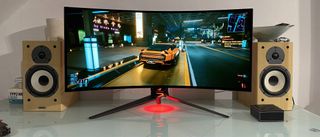
A very impressive panel from LG loaded into a lovely monitor from Asus. It's just incredibly expensive versus the incumbent QD-OLEDs, especially Alienware's.
PC Gamer score: 87%
For
- Improved brightness
- 240Hz refresh rate
- Fantastic speed
- HDR performance
Against
- Brightness still not perfect
- Fairly silly price tag
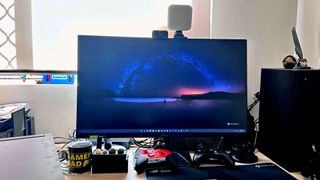
The MAG 274UPF is a good, safe 4K gaming monitor that doesn’t break the bank but it also doesn’t do anything we haven’t seen before.
PC Gamer score: 85%
For
- Excellent gaming performance
- Good color reproduction
- Surprisingly decent HDR
- Support for FreeSync and G-Sync
Against
- Doesn't offer anything new
- Small for 4K
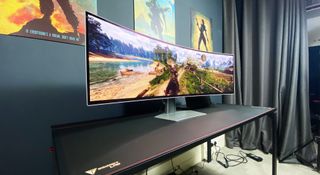
Samsung has just raised the bar for gaming monitors. The new Samsung Odyssey OLED G9 G93SC takes its already outstanding QD-OLED panel tech and stretches it out to epic 49-inch, 32:9 aspect proportions. The results are suitably stupendous. But we'd probably still prefer the more mainstream 21:9 alternatives.
PC Gamer score: 90%
For
- Outrageous 32:9 OLED panel
- HDR the way it's meant to be
- Mostly gorgeous design and build
Against
- Not exactly cheap
- 32:9 aspect isn't for everyone
- Mediocre pixel density
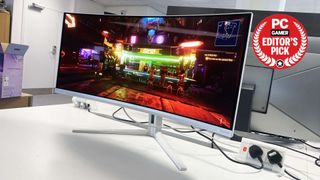
If Alienware's very similar 34-inch model was the OLED monitor we've been waiting for, Philips has just bested it. Thanks to a glossy panel coating, the OLED tech really sings. HDR games? They positively sizzle. A few minor OLED limitations remain. But this is one of the best gaming monitors you can currently get.
PC Gamer score: 95%
For
- Glossy panel lets OLED tech sing
- Super speedy performance
- Fewer OLED downsides than the competition
Against
- Very expensive
- Pixel density is nothing special
- Some brightness limitations remain
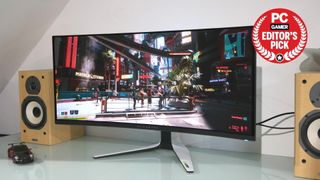
It’s been an incredibly long time coming but OLED awesomeness has finally come to the PC. LCD technology still has the edge for latency, but this quantum dot-enhanced OLED screen is outstanding when it comes to contrast, HDR performance, and response. Net result? Simply one of the best gaming monitors on the market.
PC Gamer score: 95%
For
- Fabulous contrast and colours
- Stupendous pixel response
- Genuine HDR capability
Against
- Not a great all-purpose panel
- Latency isn't a strong point
- No HDMI 2.1
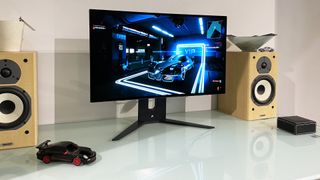
Corsair's take on the 27-inch 1440p OLED is beautifully engineered and all the usual LG-powered OLED upsides stand out, including warp-speed responses and lovely per-pixel lighting. But so does the inconsistent brightness. And that's a little tricky to accept at this lofty price point.
PC Gamer score: 80%
For
- Outrageous pixel response
- Per-pixel OLED lighting
- Nicely engineered
Against
- Inconsistent brightness
- Very expensive for a 27-inch panel
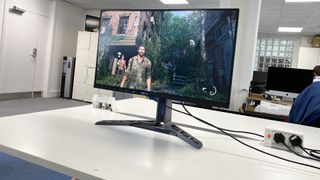
When it comes to image detail, pixel density counts and the 32-inch 4K Lenovo Legion Y32p-30 undoubtedly delivers on that front. Factor in a 144Hz refresh rate and great response, and the upshot is a proper high-DPI gaming experience. The problem is the price and the knowledge that OLED gaming can be had for not much more money.
PC Gamer score: 84%
For
- Sweet 4K IPS panel
- Zippy response and latency
- Nice build quality
Against
- Limited HDR support
- Expensive
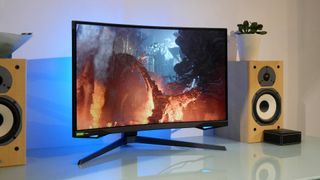
With the new G7, Samsung has buried the idea that VA panels can't be quick. However the extreme panel curve and mediocre HDR implementation complicate the proposition, and there are better monitors around for the money.
PC Gamer score: 85%
For
- Stellar VA panel with great response
- Buttery-smooth refresh
- Great design and quality
Against
- HDR implementation is disappointing
- Curve is very extreme
- Painfully pricey for a 27-inch panel
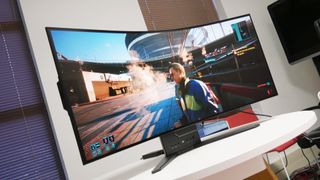
Waiting for the big-screen monitor that really delivers on the promise of OLED tech? This isn't it. The Corsair Xeneon Flex 45WQHD240 suffers from all-too-apparent brightness limitations, while the resolution and pixel density are a very hard sell at this price point.
PC Gamer score: 68%
For
- Ultra-fast response time
- Pretty much perfect black levels
- Good connectivity
Against
- Disappointing full-screen brightness
- Feels fragile when flexing
- Relatively low resolution
- A 42-inch 4K OLED gaming TV is half the price
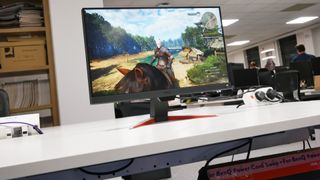
The cheaper of two superficially similar monitor models, the BenQ Mobiuz EX240N looses a little too much in the transition from IPS to VA panel tech. The pixel response can be problematic, the HDR support is woeful and there's an overall lack of vibrancy and punch. Then there's the slightly fuzzy font rendering and maddening OSD menu. 165Hz refresh is undoubtedly impressive at this price point, but we'd spend that little but more on the non-"N" model.
PC Gamer score: 70%
For
- Very low price
- 165Hz refresh and good latency
- Doesn't look cheap
Against
- Mediocre response
- Not very bright
- Silly OSD menu and options
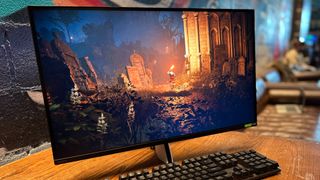
All in, the Inzone M9 is a hell of a gaming monitor, especially for Sony's first foray into PC gaming. I'm just as surprised as you are that the M9 easily competes with some of the best 4K monitors out there right now. It's loaded with a ton of gaming features and most importantly costs less than $1,000.
PC Gamer score: 87%
For
- Excellent contrast
- Exclusive PS5 features
- Great look
Against
- Limited mobility
- 2W speakers are weak
- PS5 features should be on PC too
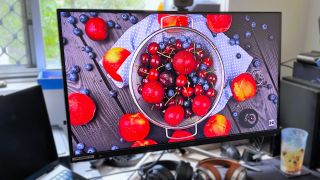
As a content creator and designer, I can appreciate the benefit of a monitor that I can also use for professional work but also get lost in the glorious world of Elden Ring. The Predator X32 FP makes a compelling case for Mini LED gaming monitors but it does so at a truly hefty price.
PC Gamer score: 79%
For
- Stunning HDR Gaming
- Four HDMI 2.1 with VRR
- Plenty of USB ports with KVM
- 90W USB Type-C PD
- FreeSync Premium Pro
Against
- So expensive
- Still some blooming
- Few local dimming zones

The MAG 274UPF is a good, safe 4K gaming monitor that doesn’t break the bank but it also doesn’t do anything we haven’t seen before.
PC Gamer score: 85%
For
- Excellent gaming performance
- Good color reproduction
- Surprisingly decent HDR
- Support for FreeSync and G-Sync
Against
- Ultimately doesn't do anything new
- Small for 4K
Best computer speakers | Best gaming headset | Best gaming laptop | Best wireless gaming headset | Best PC controller | Best capture card
How we test gaming monitors
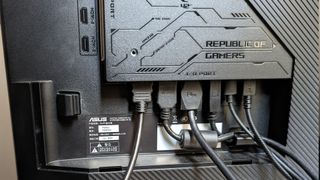
How does PC Gamer test gaming monitors?
Like everything else we test, we live with a gaming monitor in the same way you would at home. We make sure to use it for day-to-day monitor tasks on the Windows desktop—because your PC likely isn't just for entertainment—and we test it while gaming, of course.
The Windows desktop will highlight any failings in factory calibration, and show up any issues with font scaling, too. It is also a good way to test the vagaries of whatever backlighting tech a panel is employing. Using a dark background and a light browser or Explorer window (or the other way around) is great for highlighting what a screen's backlight will do as the level of brightness is demanded by what's on the display.
It's a good way to check out any auto brightness limiting (ABL) functions on a modern OLED display, too.
Using fast-paced shooters is a perfect way to test out the response of a given gaming monitor, and the neon-dripping world of Cyberpunk 2077 makes for an excellent HDR tester.
We also go through a series of experiential tests to highlight any ghosting, backlighting issues, or general smeariness or blurring of images. We find it too easy to get lost in the weeds of specific panel benchmarks and miss more obvious problems that might crop up during day-to-day gaming use.
So, we put more weight on what it's like to actually use a gaming monitor than what the specs might say.
Where to buy a gaming monitor
Where are best gaming monitor deals?
In the US:
- Amazon - Money off high refresh rate gaming monitors
- Walmart - Save on quick gaming monitors
- B&H Photo - Gaming monitors for as little as $110
- Best Buy - Often Samsung gaming monitors going for less
- Target - LG and Asus gaming monitors on sale
- Staples - Regular sales on selected HP gaming monitors
- Newegg - Lots of cheap gaming monitors to choose from
- Dell - Money off Alienware gaming monitors
In the UK:
- Amazon - Save on big-name monitor brands
- Overclockers - 1440p LG gaming monitors from £190
- Scan - AMD FreeSync monitors from as low as £100
- CCL - deals on the best screens around
- Box - discounts and refurbished monitors abound
Best gaming monitor FAQ
Should I go for an IPS, TN or VA panel?
We would always recommend an IPS panel over TN. The clarity of image, viewing angle, and color reproduction are far superior to the cheaper technology, but you'll often find a faster TN for cheaper. The other alternative is VA tech, which is less expensive than IPS but still a lot better than TN. The colors aren't quite so hot, but the contrast performance is impressive.
Should I go for a FreeSync or G-Sync monitor?
In general, FreeSync monitors will be cheaper. It used to be the case that they would only work in combination with an AMD GPU. The same went for G-Sync monitors and Nvidia GPUs. Nowadays, though, it is possible to find G-Sync compatible FreeSync monitors if you're intent on spending less, which work perfectly well with both AMD and Nvidia graphics cards.
Should I buy a HDR monitor?
With a High Dynamic Range monitor, you can take advantage of the ever-growing list of games and apps that feature HDR support. It offers more vibrant colors and greater contrast but is going to drive up the price a little. Windows' native HDR function also leaves a lot to be desired, and you may find you have to fiddle in the settings to get HDR looking like it should.
What aspect ratio should I go for?
Today's movies and games are best enjoyed in a widescreen format at a 16:9 aspect ratio or above. In 4:3, those cinematic moments will look stunted with black strips along the top and bottom. There are a host of minute variations on each ratio, but at the end of the day choosing between these depends entirely on your personal preference.
And the very far-out option, if you have a little extra cash to blow, are ultra-wide aspect ratios like 21:9 and 32:9 and their variants. These will provide a much more immersive, encompassing experience. Or you can encompass yourself with a curved monitor, it's really up to you.
Jargon buster - gaming monitor terminology
Refresh Rate (Hz)
The speed at which the screen refreshes. For example, 144Hz means the display refreshes 144 times a second. The higher the number, the smoother the screen will appear when you play games.
V-Sync
Graphics tech synchronizes a game's framerate with your monitor's refresh rate to help prevent screen tearing by syncing your GPU frame rate to the display's maximum refresh rate. Turn V-Sync on in your games for a smoother experience, but you'll lose information, so turn it off for fast-paced shooters (and live with the tearing). Useful if you have an older model display that can't keep up with a new GPU.
G-Sync
Nvidia's frame synching tech that works with Nvidia GPUs. It basically allows the monitor to sync up with the GPU. It does this by showing a new frame as soon as the GPU has one ready.
FreeSync
AMD's take on frame synching uses a similar technique as G-Sync, with the biggest difference being that it uses DisplayPort's Adaptive-Sync technology which doesn't cost monitor manufacturers anything.
Ghosting
When movement on your display leaves behind a trail of pixels when watching a movie or playing a game, this is often a result of a monitor having slow response times.
Response Time
The amount of time it takes a pixel to transition to a new color and back. Often referenced as G2G or Grey-to-Grey. Slow response times can lead to ghosting. A suitable range for a gaming monitor is between 1-4 milliseconds.
TN Panels
Twisted-nematic is the most common (and cheapest) gaming panel. TN panels tend to have poorer viewing angles and color reproduction but have higher refresh rates and response times.
IPS
In-plane switching panels offer the best contrast and color despite having weaker blacks. IPS panels also tend to be more expensive and have higher response times.
VA
Vertical Alignment panels provide good viewing angles and have better contrast than even IPS but are still slower than TN panels. They are often a compromise between a TN and IPS panel.
Curved Panels
Curved panels can make games feel more immersive and the amount of curvature is given by a number such as 1500R or 1800R. The smaller the number, the more tightly curved the screen will be.
HDR
High Dynamic Range. HDR provides a wider color range than normal SDR panels and offers increased brightness. The result is more vivid colors, deeper blacks, and a brighter picture.
Peak Brightness
This refers to the maximum brightness of a monitor or television and is measured in nits. For decent HDR gaming, you want more than 400 nits, ideally near the 1000 mark.
Ultrawide
Shorthand for monitors with aspect wider aspect ratios like 32:9 or 21:9
Resolution
The number of pixels that make up a monitor's display, indicated by height and width. For example: 1920 x 1080 (aka 1080p), 2560 x 1440 (2K or 1440p), and 3840 x 2160 (4K).
PC Gamer Newsletter
Sign up to get the best content of the week, and great gaming deals, as picked by the editors.

Dave has been gaming since the days of Zaxxon and Lady Bug on the Colecovision, and code books for the Commodore Vic 20 (Death Race 2000!). He built his first gaming PC at the tender age of 16, and finally finished bug-fixing the Cyrix-based system around a year later. When he dropped it out of the window. He first started writing for Official PlayStation Magazine and Xbox World many decades ago, then moved onto PC Format full-time, then PC Gamer, TechRadar, and T3 among others. Now he's back, writing about the nightmarish graphics card market, CPUs with more cores than sense, gaming laptops hotter than the sun, and SSDs more capacious than a Cybertruck.
- Phil Iwaniuk
- Kizito Katawonga
- Jeremy LairdHardware writer
- Jorge JimenezHardware writer, Human Pop-Tart
- Jacob RidleySenior Hardware Editor
Most Popular

